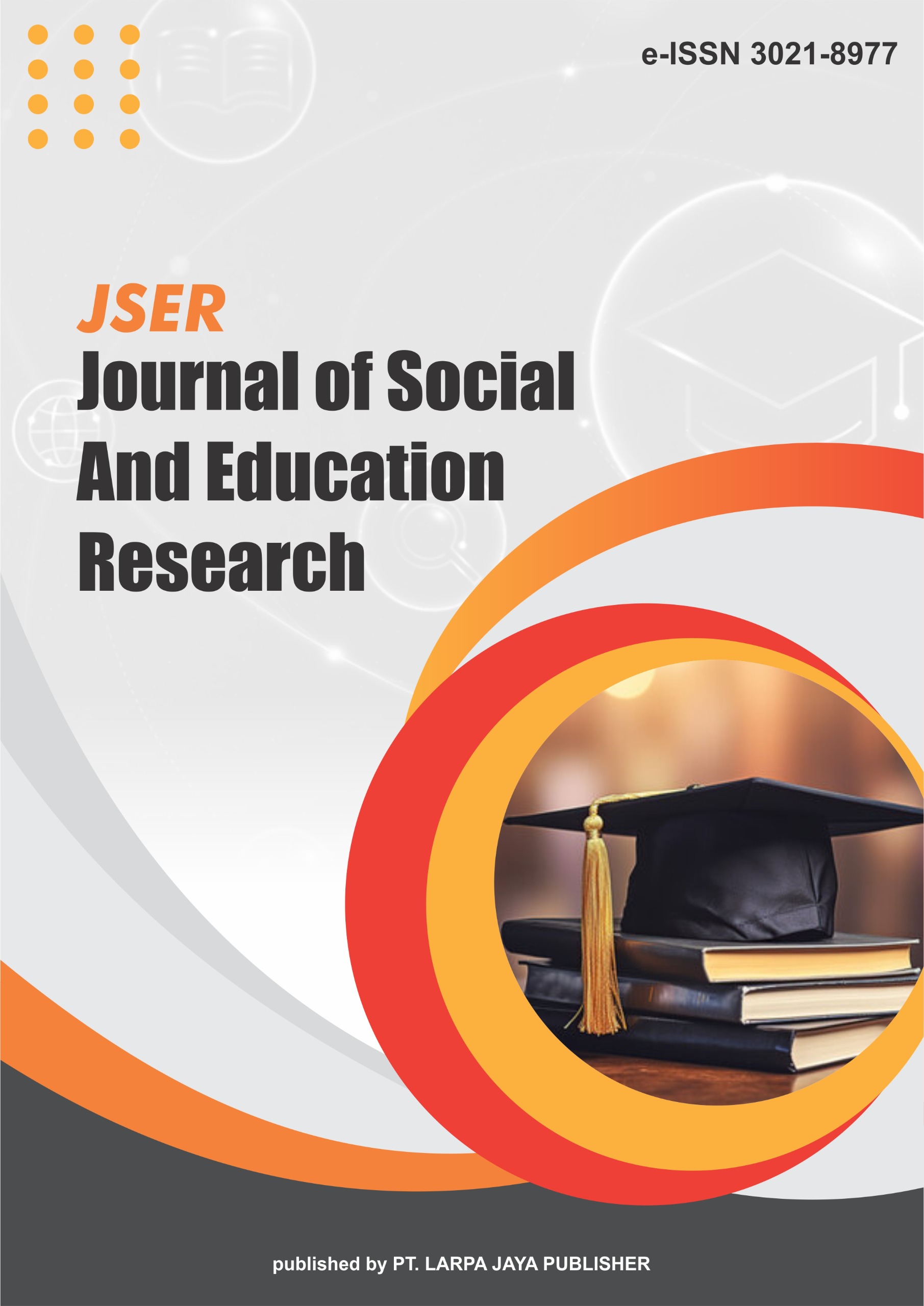Implementation of Warm Compress Therapy for Hyperthermia in Patients with Tropical Malaria: A Case Study
DOI:
https://doi.org/10.63265/jser.v3i3.140Keywords:
Hyperthermia, Tropical malaria, Warm compressAbstract
Malaria is an infectious disease transmitted by infected female Anopheles mosquitoes. This disease is caused by the parasitic Plasmodium protozoa that enter the human bloodstream through mosquito bites. Among the various types of Plasmodium that can infect humans, Plasmodium knowlesi, Plasmodium vivax, Plasmodium ovale, Plasmodium malariae, and Plasmodium falciparum are the most dangerous because they can cause death or serious complications. This case study aims to evaluate the effect of warm compresses on hyperthermia in tropical malaria patients in class I & II rooms of Serui Regional Hospital, Papua on February 18, 2025. The author uses a descriptive research method by conducting observations and observations using a nursing process approach. The results of the study showed that the application of warm compress therapy to hyperthermia combined with pharmacological therapy was effective in overcoming hyperthermia in tropical malaria patients. There was a decrease in body temperature from 39.8 ? to 36.7 ? after implementation for 1 day. Monitoring vital signs and evaluating body temperature regularly is very important to assess the effective ness of the intervention. Conclusion: This study emphasizes the effect of warm compress as a non-pharmacological approach in the management of hyperthermia in tropical malaria patients to reduce body temperature and prevent further complications.
References
Alim, S., Kasman, K., & Rusli, R. (2020). Faktor Yang Berhubungan Dengan Kejadian Malaria. Journal of Professional Health, 1(2), 57-63.
Alimul Hidayat, A. A. (2009). Metode Penelitian Keperawatan dan Teknik Analisis Data. Jakarta: Salemba Medika.
American Academy of Nursing. (2022). Position statement on patient safety: Comprehensive allergy assessment in nursing practice. Journal of the American Academy of Nursing, 2(3), 114-125.
Anisa, N. (2019). Penerapan Kompres Hangat Pada Pasien Hipertermi: Studi Kasus. Universitas Muhammadiyah Surakarta.
Anwariyah, Siti, Hainun Nisa, & Tetty Rina Aritonang. (2023). Efektivitas kompres air hangat terhadap penurunan suhu tubuh pada anak yang mengalami demam di Praktek Mandiri Bidan Vera Anjarina Karawang. STIKes Medistra Indonesia.
Arisjulyanto, D., & Suweni, K. (2024). Pengaruh penyuluhan terhadap tingkat pengetahuan masyarakat tentang malaria di Kabupaten Kepulauan Yapen. Jurnal Kesehatan Tropis Indonesia, 2(1), 1-8.
Ashley, E. A., Pyae Phyo, A., & Woodrow, C. J. (2022). Malaria. The Lancet, 397(10290), 1550-1562.
Astuti, H. P., Karolina, E., & Dewi, M. (2023). Tingkat pengetahuan remaja putri tentang asupan cairan pada demam tifoid. Jurnal Keperawatan Priority, 6(1), 134-145.
Aurelia, S. H., Layland, K., & Frysna, D. (2022). Kompres Hangat Menurunkan Suhu Tubuh Pada Pasien Hipertermi. Jurnal Health Sains, 3(2), 191-195.
Balia, A.R (2022). Studi kasus asuhan keperawatan anak dengan masalah malaria pada An. Y.K di ruang Theresia RSU Gunung Malaria Tomohon. Karya Tulis Ilmiah, Program Diploma Tiga Keperawatan, Sekolah Tinggi Ilmu Kesehatan Gunung Maria Tomohon.
Battle, K. E., Lucas, T. C. D., & Nguyen, M. (2022). Mapping the global endemicity and clinical burden of Plasmodium vivax, 2000–20. The Lancet, 399(10333), 1388-1400.
Butcher, H. K., Bulechek, G. M., & McCloskey Dochterman, J. M. (2023). Nursing Interventions Classification (NIC) (8th ed.). St. Louis, MO: Elsevier.
Cahyaningrum, E. D. (2017). Kompres Tepid Sponge dan Pemberian Parasetamol Efektif Terhadap Penurunan Suhu Tubuh Pada Anak Dengan Hipertermi. Universitas Gadjah Mada.
Carter, R., & Mendis, K. N. (2019). Evolutionary and historical aspects of the burden of malaria. Clinical Microbiology Reviews, 15(4), 564-594.
Casman, C., Fitriyana, I., & Triwibowo, C. (2023). Pengaruh kompres hangat terhadap penurunan suhu tubuh pada pasien demam di Ruang ICU. Jurnal Keperawatan Silampari, 6(2), 889-897.
Centers for Disease Control and Prevention. (2020). Malaria's impact worldwide. Retrieved from https://www.cdc.gov/malaria/malaria_worldwide/impact.html
Cheaveau, J., Nguyen, H., & Chow, B. (2022). Clinical performance of commercial LAMP tests for malaria diagnosis: A systematic review and meta-analysis. PLoS Medicine, 19(5), e1004011.
Dayat, R., & Banyal, N. A. (2025). Epidemiologi malaria di Indonesia: Pemetaan faktor risiko dan strategi pengendalian. Jurnal Kedokteran Indonesia, 12(1), 45-57.
Dimi, S., & Adam, K. (2020). Perilaku dan lingkungan sebagai determinan kejadian malaria di wilayah endemis. Jurnal Kesehatan Masyarakat, 15(3), 398-410.
Dinas Kesehatan Kabupaten Kepulauan Yapen. (2023). Profil Kesehatan Kabupaten Kepulauan Yapen Tahun 2023. Serui: Dinas Kesehatan Kabupaten Kepulauan Yapen.
Dinas Kesehatan Provinsi Papua. (2023). Profil Kesehatan Provinsi Papua Tahun 2023. Jayapura: Dinas Kesehatan Provinsi Papua.
Doenges, M. E., Moorhouse, M. F., & Murr, A. C. (2023). Nursing care plans: Guidelines for individualizing client care across the life span (11th ed.). Philadelphia, PA: F.A. Davis Company.
Dondorp, A. M., & White, N. J. (2023). Advances in malaria management. Lancet Infectious Diseases, 23(7), e221-e232.
Doolan, D. L., Dobano, C., & Baird, J. K. (2021). Acquired immunity to malaria. Clinical Microbiology Reviews, 34(1), e00145-19.
Ea, R. S., Kristianto, H., & Santoso, A. (2020). Efektivitas Pemberian Kompres Air Hangat Dalam Menurunkan Suhu Tubuh Pada Pasien Dengan Demam. NurseLine Journal, 5(2), 181-189.
Evani, S. (2023). Gejala dan Penanganan Malaria di Indonesia. Jakarta: Bumi Medika.
Faridah, I. (2021). Perbedaan efektifitas kompres hangat dan dingin untuk menurunkan suhu tubuh pada anak demam. Jurnal SMART Keperawatan, 8(1), 58-64.
Fitriany, J., & Sabiq, A. (2018). Malaria. Jurnal Averrous, 4(2), 1-20.
Gething, P. W., & Tatem, A. J. (2022). Mapping human populations and malaria risk. Nature Reviews Microbiology, 20(7), 431-443.
Grove, S. K., & Gray, J. R. (2022). Understanding nursing research: Building an evidence-based practice (8th ed.). St. Louis, MO: Elsevier.
Hana, R. (2023). Penderita Malaria Pemeriksaan Dan Penangannya. Jurnal Ilmu Kesehatan, 12(1), 153-165.
Herdman, T. H., & Kamitsuru, S. (2022). NANDA International nursing diagnoses: Definitions and classification 2021-2023 (12th ed.). New York, NY: Thieme.
Huda, I. (2018). Hipertermi: Patofisiologi, Manifestasi Klinis, dan Penatalaksanaan. Malang: Pusat Penerbitan dan Publikasi Universitas Islam Malang.
Ina, A. (2024). Pemberantasan Penyakit Malaria Dengan Pendekatan Keluarga. Jurnal Kesehatan Masyarakat, 10(1), 45-57.
International Council of Nurses. (2022). Position statement: Nursing care of patients with infectious diseases. Geneva: ICN.
Jarvis, C., & Eckhardt, A. (2023). Physical examination and health assessment (8th ed.). St. Louis, MO: Elsevier.
Kahi, J. (2024). Metode Penulisan Studi Kasus dalam Ilmu Keperawatan. Manokwari: Penerbit Universitas Papua.
Kemenkes RI. (2019). Pedoman Manajemen Malaria. Jakarta: Kementerian Kesehatan Republik Indonesia.
Kemenkes RI. (2021). Profil Kesehatan Indonesia Tahun 2021. Jakarta: Kementerian Kesehatan Republik Indonesia.
Kemenkes RI. (2023). Panduan Praktik Klinis Bagi Perawat dalam Penatalaksanaan Malaria. Jakarta: Kementerian Kesehatan Republik Indonesia.
Kozier, B., Erb, G., Berman, A., & Snyder, S. (2022). Fundamentals of nursing: Concepts, process, and practice (11th ed.). Upper Saddle River, NJ: Pearson.
Lalloo, D. G., Shingadia, D., & Bell, D. J. (2023). Special considerations for malaria in children. The Pediatric Infectious Disease Journal, 42(3), 265-272.
Lalremruata, A., Jeyaraj, S., & Engleitner, T. (2021). Species-specific biology of human malaria parasites: Insights from genomics and transcriptomics. Nature Reviews Microbiology, 19(9), 597-614.
Lewis, S. L., & Bucher, L. (2023). Medical-surgical nursing: Assessment and management of clinical problems (11th ed.). St. Louis, MO: Elsevier.
Malaria Consortium. (2022). Clinical assessment of malaria: A practical guide. London: Malaria Consortium.
Masruroh, R., Hartini, S., & Astuti, R. (2017). Efektivitas pemberian kompres hangat dalam menurunkan suhu tubuh pada anak demam. Jurnal Ilmu Keperawatan Anak, 1(1), 30-35.
Mulyani, S., & Lestari, T. (2020). Efektivitas Kompres Hangat dan Dingin Terhadap Penurunan Demam Pada Balita. Jurnal Ilmiah Kesehatan, 12(2), 172-180.
National Institute of Allergy and Infectious Diseases. (2023). Malaria: Understanding the disease and its global impact. Bethesda, MD: NIAID.
Nopianti, Septi Viantri Kurdaningsih, & Widya Arisandy. (2023). Penerapan kompres hangat untuk menurunkan hipertemia pada anak yang mengalami kejang demam. Babul Ilmi_Jurnal Ilmian Multi Science Kesehatan, 15(2), 171-184.
O'Brien, M. E. (2021). Spirituality in nursing: Standing on holy ground (7th ed.). Burlington, MA: Jones & Bartlett Learning.
Palapessy, N. A., Soplanit, R. A., & Tamtelahitu, J. A. (2024). Upaya Pencegahan dan Penanggulangan Malaria di Indonesia Timur. Jurnal Keperawatan Global, 9(1), 38-49.
Pawestri, R. (2023). Kompres hangat dalam menurunkan suhu tubuh pada anak dengan demam. Jurnal Kesehatan Indonesia, 11(2), 239-249.
Pittara, A. (2022). Hipertermia: Penyebab, Gejala, dan Cara Mengatasinya. Jurnal Kesehatan Medika, 8(1), 55-62.
Potter, P. A., Perry, A. G., Stockert, P. A., & Hall, A. M. (2021). Fundamentals of nursing (10th ed.). St. Louis, MO: Elsevier.
PPNI, Tim Pokja SDKI. (2019). Standar Diagnosa Keperawatan Indonesia: Definisi dan Indikator Diagnostik (2nd ed.). Jakarta: DPP PPNI.
Price, S. A., Hall, K. M., & Lorenz, N. (2022). Pathophysiology: An introduction to the mechanisms of disease (8th ed.). St. Louis, MO: Elsevier.
Ramba, T. (2022). Komplikasi Malaria dan Penanganannya. Jurnal Kedokteran Tropis, 5(1), 27-38.
Rogerson, S. J., Unger, H. W., & Ome-Kaius, M. (2022). Malaria in pregnancy. The Lancet, 400(10353), 642-654.
Rollback Malaria Partnership. (2022). Action and investment to defeat malaria 2022-2030. Geneva: World Health Organization.
Rumbiak, H. (2024). Epidemiologi Malaria di Papua: Studi Retrospektif 2020-2023. Papua Journal of Medicine, 3(1), 14-26.
Sandi, R. (2022). Pengaruh Kompres Hangat Terhadap Penurunan Suhu Tubuh Pada Pasien Dengan Hipertermi. Jurnal Ilmu Kesehatan Bhakti Husada, 13(1), 58-65.
Seran, M. (2019). Malaria: Epidemiologi, Patofisiologi, Manifestasi Klinis, dan Penanganan. Jakarta: EGC.
Sienny, A. (2024). Manfaat Kompres Hangat Pada Nyeri Sendi. Jurnal Kesehatan Masyarakat, 7(1), 25-31.
Siregar, A. Y., Hidayat, D., & Malik, S. (2023). Beban Ekonomi dan Dampak Kesehatan Akibat Malaria di Indonesia. Jurnal Ekonomi Kesehatan Indonesia, 8(1), 31-42.
Sugiyono. (2022). Metode Penelitian Kuantitatif, Kualitatif, dan R&D (3rd ed.). Bandung: Alfabeta.
Sultoni, M. (2018). Kompres Hangat dalam Pengurangan Nyeri: Kajian Teoritis dan Praktis. Yogyakarta: Graha Ilmu.
Suparti, S., Nursalam, N., & Haryanto, J. (2020). Efektivitas kompres dingin dan hangat terhadap suhu tubuh pasien hipertermi. Jurnal Ners, 15(2), 132-139.
Taylor, C., Wilson, L., & Kowalak, J. P. (2021). Nursing fundamentals: The art and science of person-centered care (9th ed.). Philadelphia, PA: Wolters Kluwer.
Tim Pokja SDKI DPP PPNI. (2018). Standar Diagnosa Keperawatan Indonesia: Definisi dan Indikator Diagnostik (1st ed.). Jakarta: DPP PPNI.
Tim Pokja SIKI DPP PPNI. (2018). Standar Intervensi Keperawatan Indonesia: Definisi dan Tindakan Keperawatan (1st ed.). Jakarta: DPP PPNI.
Tim Pokja SLKI DPP PPNI. (2018). Standar Luaran Keperawatan Indonesia: Definisi dan Kriteria Hasil (1st ed.). Jakarta: DPP PPNI.
Wang, L., Zou, Y., & Liu, Y. (2023). Advances in rapid diagnostic tests for malaria. Frontiers in Cellular and Infection Microbiology, 13, 1143853.
White, N. J., Pukrittayakamee, S., & Hien, T. T. (2022). Advances in malaria pathophysiology. New England Journal of Medicine, 387(12), 1128-1142.
Wood, T. R., Burchett, J. R., & Williams, S. G. (2023). Heat illness: Diagnosis, treatment, and prevention. New York, NY: Oxford University Press.
World Health Organization. (2020). Guidelines for the treatment of malaria (4th ed.). Geneva: World Health Organization.
World Health Organization. (2021). World malaria report 2021. Geneva: World Health Organization.
World Health Organization. (2022). Guidelines for malaria. Geneva: World Health Organization.
World Health Organization. (2023). Global technical strategy for malaria 2023-2030. Geneva: World Health Organization.
Yildirim, D., & Ozkahraman, S. (2022). Current approaches in nursing implementation documentation. Journal of Nursing Research, 30(4), e215.
Downloads
Published
How to Cite
Issue
Section
License
Copyright (c) 2025 Journal of Social And Education Research

This work is licensed under a Creative Commons Attribution-NonCommercial 4.0 International License.










